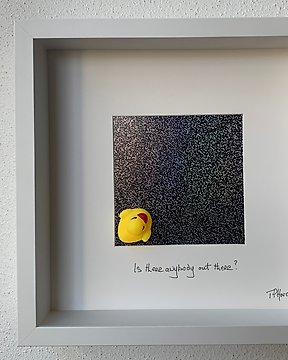
T P Hardisty - Is there anybody out there ?
Nr. 18630923

Nr. 18630923

High quality artistic textured screen printing, limited edition of only 50 copies.
Dry stamp of the printer and publisher (TriArt) and guarantee certificate of La Riva Art Gallery.
ARTIST’S BIOGRAPHY:
Ugo Nespolo was born in 1941 and graduated from the Academy of Fine Arts in Turin. His beginnings are placed in the lively cultural climate of the ‘60s in Turin and Milan and in particular in the framework of the Schwarz Gallery, where he held his first solo show in 1968. The pop climate that dominates the culture of those years forms his beginnings, but Nespolo soon turns his attention to a sort of proto-conceptualism. In his constant search for techniques and means of expression, Nespolo turns to experimental cinema, which in those years took on a decisive cultural importance thanks to the work of the New American Cinema. Since 1967, with Grazie Mamma Kodak, his film path unfolds in a showcase of works, including Le porte girevoli from 1982. His actors are artists like Lucio Fontana, Enrico Baj, Michelangelo Pistoletto. Monographic events are dedicated to him by the major museums of the world such as the Philadelphia Museum of Modern Art, the Filmoteka Polska in Warsaw, the Wallraf Richartz Museum in Cologne, the Centre George Pompidou in Paris, which in 1984 organized the retrospective Nespolo, Le cinema Diagonal. His great work Il Museo in 1975/6, exhibited for the first time at the Progressive Museum of Contemporary Art in Livorno, is considered a key work to read the ironic and complex vein that furnishes all the eclectic work of Nespolo and also for well understand his complex executive technique. This large painting was subsequently hosted by many Museums and Art Galleries and still figured as the fulcrum of the great exhibition that the City of Milan dedicated to him in April 1990 at Palazzo Reale. Faithful to the dictates of the Vanguards of ' bringing the art to life', Nespolo is convinced that the work of the contemporary artist should cross the boundaries of the specific assigned from late romantic clichés. For this reason, for many years, he has been very successful in some forms of "applied art" such as theatrical scenography and ceramics. Ugo Nespolo is an artist to whom is recognized a very difficult operation: to stop the spell of fireworks and discover the secret by combining it with the palette of emotions. The colours that Nespolo materializes in his paintings have the same strength and the same colour of tin toys, comics, and some of the bright advertisements from the fifties. But this is only a game of assonances, of evocations that awaken dormant memories. Nespolo, in his chromatic research, beyond the essence of colours he seems to chase the mystery, that mystery that has roots in the abysses of our unconscious, where they probably live as pure energy. Here is the great Nespolo’s skill: awaken that chromatic energy and make it imprint on the canvas or in his imaginative mosaics as in a dance, and the crossing of the figures in all this is just enjoyable to widen the horizons of the game. Ugo Nespolo has always carried out a personal research that adopted the technique of citation and combinatorial procedures, orientating the paths of his experimentation in different directions, with surprisingly unscrupulous results. Think of the splendid series of paintings inspired by some famous films, in which the image merges with the movement of action, concentrating and at the same time relaxing the intrinsic instincts of the story. But next to the cinema you can feel the most varied cultural and literary suggestions, up to the hints taken from advertisements to comics in a continuous search for the novelty in the edited. Nespolo builds the picture like a puzzle, in which the chromatic backgrounds of the tesserae come to connect with each other, composing in a subtle balance multiplicity and uniqueness, movement and suspension, variety in design and neatness in the sign. In articulating and reconciling these components, variously scanned and fearful, the effects flow on a large keyboard: From the live and bright chromaticism, with moments of a suggestion that we would say funambulary, to a progressive attenuation of colours and contrasts, which can create atmospheres and suspended, melancholy regret and existential withdrawal, as a reflection on the fragility and emptiness of a life that, in other paintings, it seems to celebrate its most luminous triumphs: according to a dialectic that is not destined to be composed in a pacifying way. To the extent that art is a mirror of the physical and metaphysical condition of man, it can only re-propose a continuous story of openings and closures: hence the seriality, the recovery, the variation, the play of the combinatorial procedures. Ugo Nespolo elaborates his pictures on the computer, composes and recomposes the images, but the execution of the painting is then entrusted to his manuality, which cuts out the wooden tesserae, smooths the outlines, colours them and fits them into the whole artwork.
Zo koop je op Catawiki
1. Ontdek iets bijzonders
2. Plaats het hoogste bod
3. Veilig betalen